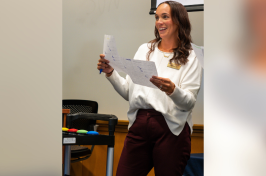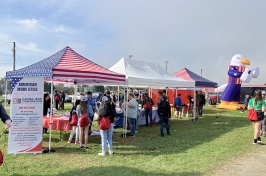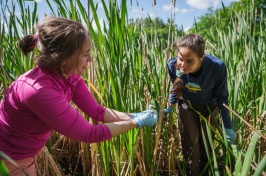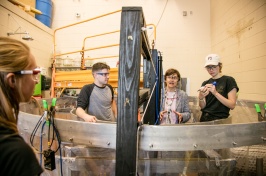UNH Forest Watch Celebrates Banner Year on May 31 in Durham

Barry Rock mentors a group of Forest Watch students during the summer of 2012. Photo by Kristi Donahue, UNH-EOS.
This past year, the University of New Hampshire's Forest Watch program doubled the number of participating schools with more than 1,000 students from 28 schools collecting samples, measuring foliage, and analyzing spectral data to assess white pine health across the New England region. Students also collected data for a new component of the program monitoring the health of sugar maples.
Now in its 23rd year, the K-12, inquiry-based science program will celebrate its recent growth and successful research efforts when an estimated 100 students visit the UNH Durham campus Friday, May 31, 2013, for the program's third annual convention.
Students will present their most recent research findings to the program's founding director Barrett Rock, professor emeritus of the UNH Institute for the Study of Earth, Oceans, and Space and the department of natural resources and the environment, and other forestry scientists.
"These students have alerted us to needle damage in white pine not seen during the first two decades of the program," says Rock. "As a result of the revitalization of the program, and adding Maple Watch activities, the data from students is helping UNH scientists assess overall forest health issues region wide. We are learning factors other than air pollution are affecting our forests."
Maple Watch is a new component of the overall Forest Watch program and was added in the wake of evidence that the region's signature sugar maple trees are being stressed by climate change and related atmospheric pollution events.
Forest Watch coordinator Martha Carlson notes that the program's traditional protocols, which guide students and their teachers in the study of how ozone, or smog, impacts white pine health, are flexible enough to allow for a multiplicity of different applications to different age levels and curricular interests, including math, botany, physics, technology and chemistry.
Says Carlson, "Forest Watch combines botanical studies with the physics of light, atmospheric chemistry, tree chemistry and physics, and remote sensing technologies needed to study the forest. As such, the multidisciplinary program helps teachers meet new standards in Earth systems sciences."
Due to the flexibility and multidisciplinary nature of the program, many students develop their own research projects, the results of which will also be presented at this year's annual convention.
For example, students from Vermont's St. Johnsbury High School have been learning to use a form of calculus to assess chlorophyll concentrations in the pine needles they collected, and at the Bonny Eagle High School in Standish, Maine, students have adapted the program's white pine protocols to study hemlocks and vernal pools surrounding their school.
During the convention, students will also meet with a UNH plant pathologist to learn how pine weevils are damaging their young pines and see how pathologists test needles for fungal fruiting bodies that may be the cause of widespread needle cast among the white pines recently. Indeed, it was Forest Watch student-collected data that first demonstrated a dramatic loss of needles in 2012, and schools are now working with pathologists to try and understand what might have made the pines susceptible to the fungi.
Students participating in this year's convention will also be introduced to aspects of EOS research being conducted in solar plasma physics, Arctic climate change, soil fungi, and spectrophotometry.
Carlson notes that the program's summer teacher-training workshop will be held August 6, 7, and 8 at UNH and encourages interested teachers to register by visiting the program website at forestwatch.sr.unh.edu.
The University of New Hampshire, founded in 1866, is a world-class public research university with the feel of a New England liberal arts college. A land, sea, and space-grant university, UNH is the state's flagship public institution, enrolling 12,200 undergraduate and 2,300 graduate students.
-30-
Photograph to download:
http://www.eos.unh.edu/Spheres_0812/graphics/summer12_pics/rosckstu_lg.jpg
Caption: Barry Rock mentors a group of Forest Watch students during the summer of 2012. Photo by Kristi Donahue, UNH-EOS.
The Forest Watch conference will be held at Morse Hall at UNH beginning at 10 a.m. For specific details on the day's events, contact program coordinator Martha Carlson at martha.carlson@unh.edu.
Latest News
-
October 30, 2024
-
October 10, 2024
-
October 8, 2024
-
October 3, 2024
-
October 1, 2024
















































